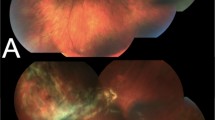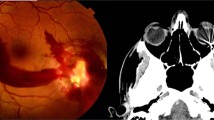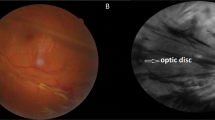Abstract
Background
To report the outcomes of chorioretinectomy versus non-chorioretinectomy in combat ocular injuries where a foreign body penetrated the choroid or perforated the globe.
Methods
Retrospective, comparative, consecutive interventional case series of 32 perforating or severe intraocular foreign body combat ocular trauma injuries sustained by United States military soldiers and treated at a single institution from March 2003 to March 2009. Final best-corrected visual acuity (BCVA) in 19 non-chorioretinectomy-treated eyes was compared to 13 chorioretinectomy-treated eyes. The chorioretinectomy group was repaired with a 20 gauge three-port pars plana vitrectomy (PPV) by removing the choroid and/or retina at the impact or perforation site of the foreign body following evacuation from a combat zone. The main outcome measures were best-corrected visual acuity and rates of globe survival, retina reattachment and proliferative vitreoretinopathy.
Results
Thirty-two eyes of 31 patients with a mean age of 29 ± 9 years (range, 19–53 years) were followed for a median of 463 ± 226 days (range, 59–1022 days). The mean time of injury to the operating room in the chorioretinectomy group was 12.6 ± 9.8 days, compared to that of the non-chorioretinectomy group of 22.1 ± 16.4 days (P = 0.05) Final BCVA ≥20/200 occurred in seven of 13 (54%) of the chorioretinectomy group, compared to two of 19 (11%) in the non-chorioretinectomy group (P = 0.04). Globe survival rates were higher in the chorioretinectomy group [11 of 13 (85%) vs 9 of 19 (45%); P = 0.06], as well as the final retinal reattachment rate [8 of 13 (62%) vs 8 of 19 (42%); P = 0.47]. The proliferative vitreoretinopathy rate was eight of 13 (62%) in the chorioretinectomy group, compared to 14 of 19 (74%) in the non-chorioretinectomy group (P = 0.70). Graft failure occurred in five of six eyes (83%) of non-chorioretinectomy cases, requiring temporary keratoprosthesis and penetrating keratoplasty.
Conclusion
Chorioretinectomy is a surgical option that may improve final BCVA and increase globe survival rates when a foreign body penetrates the choroid or perforates the globe.



Similar content being viewed by others
References
Cinotti AA, Maltzman BA (1975) Prognosis and treatment of perforating ocular injuries. The John Luhr Memorial Lecture. Ophthalmic Surg 6(4):54–61
Cleary PE, Ryan SJ (1978) Posterior perforating eye injury. Experimental animal model. Trans Ophthalmol Soc U K 98(1):34–37
Maltzman BA, Eng K, Cinotti AA (1978) Perforating ocular injuries—a second look. J Med Soc N J 75(4):317–319
Niiranen M (1981) Perforating eye injuries treated at Helsinki University Eye Hospital 1970 to 1977. Ann Ophthalmol 13(8):957–961
De Juan E Jr, Sternberg P Jr, Michels RG (1983) Penetrating ocular injuries. Types of injuries and visual results. Ophthalmology 90(11):1318–1322
Vatne HO, Syrdalen P (1985) Vitrectomy in double perforating eye injuries. Acta Ophthalmol (Copenh) 63(5):552–556
Meredith TA, Gordon PA (1987) Pars plana vitrectomy for severe penetrating injury with posterior segment involvement. Am J Ophthalmol 103(4):549–554
Punnonen E, Laatikainen L (1989) Long-term follow-up and the role of vitrectomy in the treatment of perforating eye injuries without intraocular foreign bodies. Acta Ophthalmol (Copenh) 67(6):625–632
Esmaeli B, Elner SG, Schork MA, Elner VM (1995) Visual outcome and ocular survival after penetrating trauma. A clinicopathologic study. Ophthalmology 102(3):393–400
Cardillo JA, Stout JT, LaBree L et al (1997) Post-traumatic proliferative vitreoretinopathy. The epidemiologic profile, onset, risk factors, and visual outcome. Ophthalmology 104(7):1166–1173
Martin DF, Meredith TA, Topping TM et al (1991) Perforating (through-and-through) injuries of the globe. Surgical results with vitrectomy. Arch Ophthalmol 109(7):951–956
Zivojnovic R (1987) Silicone oil in vitreoretinal surgery. Chapter 5: surgical techniques. Marinus Nijhoff, Dordrecht, pp 45–103
Kuhn F, Mester V, Morris R (2004) A proactive treatment approach for eyes with perforating injury. Klin Monatsbl Augenheilkd 221(8):622–628
Kuhn F, Morris R, Witherspoon CD, Mann L (2007) Blunt-force injuries involving the posterior segment. Retinal Physician (July/August):20–4
Johnson AJ (2007) Eye trauma management—OIF clinical considerations. J Trauma 62(6 Suppl):S20
Harlan JB Jr, Pieramici DJ (2002) Evaluation of patients with ocular trauma. Ophthalmol Clin North Am 15(2):153–161
Pieramici DJ (2002) Vitreoretinal trauma. Ophthalmol Clin North Am 15(2):225–234, vii
Kuhn F (2002) Strategic thinking in eye trauma management. Ophthalmol Clin North Am 15(2):171–177
Lakits A, Prokesch R, Scholda C et al (1998) Multiplanar imaging in the preoperative assessment of metallic intraocular foreign bodies. Helical computed tomography versus conventional computed tomography. Ophthalmology 105(9):1679–1685
Weichel ED, Colyer MH, Ludlow SE et al (2008) Combat ocular trauma visual outcomes during Operations Iraqi and Enduring Freedom. Ophthalmology 115(12):2235–2245
Mader TH, Carroll RD, Slade CS et al (2006) Ocular war injuries of the Iraqi insurgency, January-September 2004. Ophthalmology 113(1):97–104
Thach AB, Johnson AJ, Carroll RB et al (2008) Severe eye injuries in the war in Iraq, 2003–2005. Ophthalmology 115(2):377–382
Kuhn F, Morris R, Witherspoon CD et al (1996) A standardized classification of ocular trauma. Ophthalmology 103(2):240–243
Pieramici DJ, Sternberg P Jr, Aaberg TM Sr et al (1997) A system for classifying mechanical injuries of the eye (globe). The Ocular Trauma Classification Group. Am J Ophthalmol 123(6):820–831
Kuhn F, Morris R, Witherspoon CD (2002) Birmingham Eye Trauma Terminology (BETT): terminology and classification of mechanical eye injuries. Ophthalmol Clin North Am 15(2):139–143, v
Kuhn F, Maisiak R, Mann L et al (2002) The Ocular Trauma Score (OTS). Ophthalmol Clin North Am 15(2):163–165, vi
Yeh S, Colyer MH, Weichel ED (2008) Current trends in the management of intraocular foreign bodies. Curr Opin Ophthalmol 19(3):225–233
Weichel ED, Yeh S (2008) Techniques of intraocular foreign body removal. Tech Ophthalmol 6(3):88–97
Pavlovic S (1999) Primary intraocular lens implantation during pars plana vitrectomy and intraretinal foreign body removal. Retina 19(5):430–436
Moisseiev J, Segev F, Harizman N et al (2001) Primary cataract extraction and intraocular lens implantation in penetrating ocular trauma. Ophthalmology 108(6):1099–1103
Baykara M, Dogru M, Ozcetin H, Erturk H (2002) Primary repair and intraocular lens implantation after perforating eye injury. J Cataract Refract Surg 28(10):1832–1835
Dong X, Wang W, Xie L, Chiu AM (2006) Long-term outcome of combined penetrating keratoplasty and vitreoretinal surgery using temporary keratoprosthesis. Eye 20(1):59–63
Chalam KV, Shah VA, Gupta SK, Tripathi RC (2003) Evaluation and comparison of lens and peripheral retinal relationships with the use of endolaser probe and newly designed curved vitrectomy probe. Retina 23(6):815–819
Magalhaes O Jr, Chong L, DeBoer C et al (2008) Vitreous dynamics: vitreous flow analysis in 20-, 23-, and 25-gauge cutters. Retina 28(2):236–241
Kumagai K, Furukawa M, Ogino N et al (2007) Long-term visual outcomes after vitrectomy for macular edema with foveal hemorrhage in branch retinal vein occlusion. Retina 27(5):584–588
Yamakiri K, Sakamoto T, Noda Y et al (2008) One-year results of a multicenter controlled clinical trial of triamcinolone in pars plana vitrectomy. Graefes Arch Clin Exp Ophthalmol 246(7):959–966
Senn P (1991) Practical experiences in conversion to the wide angle observation systems for vitreous surgery BIOM, SDI, VPF. Klin Monatsbl Augenheilkd 198(5):480–481
Machemer R, Aaberg TM, Freeman HM et al (1991) An updated classification of retinal detachment with proliferative vitreoretinopathy. Am J Ophthalmol 112(2):159–165
Woodcock MG, Scott RA, Huntbach J, Kirkby GR (2006) Mass and shape as factors in intraocular foreign body injuries. Ophthalmology 113(12):2262–2269
Stone TW, Siddiqui N, Arroyo JG et al (2000) Primary scleral buckling in open-globe injury involving the posterior segment. Ophthalmology 107(10):1923–1926
Azad RV, Kumar N, Sharma YR, Vohra R (2004) Role of prophylactic scleral buckling in the management of retained intraocular foreign bodies. Clin Exp Ophthalmol 32(1):58–61
Warrasak S, Euswas A, Hongsakorn S (2005) Posterior segment trauma: types of injuries, result of vitreo-retinal surgery and prophylactic broad encircling scleral buckle. J Med Assoc Thai 88(12):1916–1930
Kruger EF, Nguyen QD, Ramos-Lopez M, Lashkari K (2002) Proliferative vitreoretinopathy after trauma. Int Ophthalmol Clin 42(3):129–143
Coleman DJ (1976) Pars plana vitrectomy. The role of vitrectomy in traumatic vitreopathy. Trans Sect Ophthalmol Am Acad Ophthalmol Otolaryngol 81(3 Pt 1):406–413
Williams DF, Mieler WF, Abrams GW, Lewis H (1988) Results and prognostic factors in penetrating ocular injuries with retained intraocular foreign bodies. Ophthalmology 95(7):911–916
Spalding SC, Sternberg P Jr (1990) Controversies in the management of posterior segment ocular trauma. Retina 10(Suppl 1):S76–S82
Davidson PC, Sternberg P Jr (1991) Management of posterior segment ocular trauma. Curr Opin Ophthalmol 2(3):337–343
Ahmadieh H, Sajjadi H, Azarmina M et al (1994) Surgical management of intraretinal foreign bodies. Retina 14(5):397–403
Mieler WF, Mittra RA (1997) The role and timing of pars plana vitrectomy in penetrating ocular trauma. Arch Ophthalmol 115(9):1191–1192
El-Asrar AM, Al-Amro SA, Khan NM, Kangave D (2000) Visual outcome and prognostic factors after vitrectomy for posterior segment foreign bodies. Eur J Ophthalmol 10(4):304–311
Mester V, Kuhn F (2002) Intraocular foreign bodies. Ophthalmol Clin North Am 15(2):235–242
Wani VB, Al-Ajmi M, Thalib L et al (2003) Vitrectomy for posterior segment intraocular foreign bodies: visual results and prognostic factors. Retina 23(5):654–660
Thach AB, Ward TP, Dick JS 2nd et al (2005) Intraocular foreign body injuries during Operation Iraqi Freedom. Ophthalmology 112(10):1829–1833
Bajaire B, Oudovitchenko E, Morales E (2006) Vitreoretinal surgery of the posterior segment for explosive trauma in terrorist warfare. Graefes Arch Clin Exp Ophthalmol 244(8):991–995
Colyer MH, Weber ED, Weichel ED et al (2007) Delayed intraocular foreign body removal without endophthalmitis during Operations Iraqi Freedom and Enduring Freedom. Ophthalmology 114(8):1439–1447
Szijarto Z, Gaal V, Kovacs B, Kuhn F (2008) Prognosis of penetrating eye injuries with posterior segment intraocular foreign body. Graefes Arch Clin Exp Ophthalmol 246(1):161–165
Colyer MH, Chun DW, Bower KS et al (2008) Perforating globe injuries during Operation Iraqi Freedom. Ophthalmology 115(11):2087–2093
ASOT-EVRS Prospective Trial. Proactive Management of Eyes with Perforating/Rupture/IOFB Injuries. Available at: http://useironline.org/protocol.html. Accessed June 11, 2009
Hariprasad SM, Shah GK, Mieler WF et al (2006) Vitreous and aqueous penetration of orally administered moxifloxacin in humans. Arch Ophthalmol 124(2):178–182
Sakamoto H, Sakamoto M, Hata Y et al (2007) Aqueous and vitreous penetration of levofloxacin after topical and/or oral administration. Eur J Ophthalmol 17(3):372–376
Andreoli CM, Andreoli MT, Kloek CE et al (2009) Low rate of endophthalmitis in a large series of open-globe injuries. Am J Ophthalmol 147(4):601–608, e2
Mieler WF, Ellis MK, Williams DF, Han DP (1990) Retained intraocular foreign bodies and endophthalmitis. Ophthalmology 97(11):1532–1538
Virata SR, Kylstra JA, Singh HT (1999) Corneal epithelial defects following vitrectomy surgery using hand-held, sew-on, and noncontact viewing lenses. Retina 19(4):287–290
Novak J (1997) Flexible iris hooks for phacoemulsification. J Cataract Refract Surg 23(6):828–831
Punnonen E (1990) Pathological findings in eyes enucleated because of perforating injury. Acta Ophthalmol (Copenh) 68(3):265–269
Knyazer B, Levy J, Rosen S et al (2008) Prognostic factors in posterior open-globe injuries (zone-III injuries). Clin Experiment Ophthalmol 36(9):836–841
Kuhn F, Morris R, Witherspoon CD, Mann L (2006) Epidemiology of blinding trauma in the United States Eye Injury Registry. Ophthalmic Epidemiol 13(3):209–216
DiLoreto DA Jr, Bressler NM, Bressler SB, Schachat AP (2003) Use of best and final visual acuity outcomes in ophthalmological research. Arch Ophthalmol 121(11):1586–1590
Author information
Authors and Affiliations
Corresponding author
Additional information
Poster: American Society of Retina Specialists; Indian Wells, CA, December 5, 2007.
Poster: American Academy of Ophthalmology′s Annual Meeting; Atlanta, GA, November 10, 2008.
Rights and permissions
About this article
Cite this article
Weichel, E.D., Bower, K.S. & Colyer, M.H. Chorioretinectomy for perforating or severe intraocular foreign body injuries. Graefes Arch Clin Exp Ophthalmol 248, 319–330 (2010). https://doi.org/10.1007/s00417-009-1236-x
Received:
Revised:
Accepted:
Published:
Issue Date:
DOI: https://doi.org/10.1007/s00417-009-1236-x




